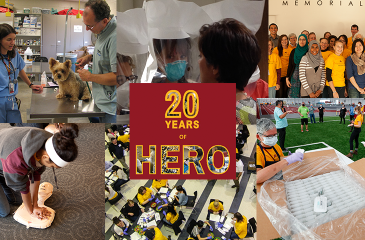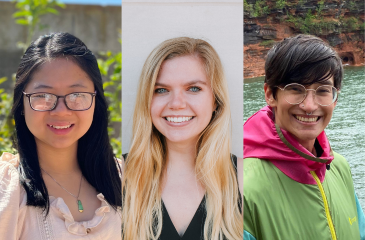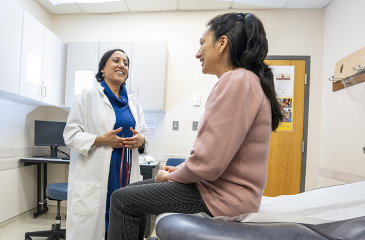If you ask Lou Clark, PhD, MFA, executive director of M Simulation, what the highest fidelity simulation modality in the center is, she would say unequivocally, “The amazing group of 200 standardized patients, because you can't get higher fidelity than people.” Clark is also quick to emphasize that the sophistication of mannequin technology is critical for teaching technical and procedural skills, but cannot fully replicate genuine human interaction.
Standardized patients (SPs) are regular people who help learners better communicate with patients. SPs portray medical conditions and can act as clients, family members, and health care professionals to simulate clinical experiences. Most importantly, they provide constructive feedback to learners about the interaction from the patient’s perspective.
In order to create authentic scenarios, it is crucial to partner with diverse groups and incorporate feedback from people who may not often be represented. The more experience learners have interacting with diverse populations, the more adept they will be in serving patients in the future.
“Diversity, equity, and inclusion has been on the forefront of simulation as a profession in the last few years. SPs play an important role in helping to teach and assess learners; we want to attract a diverse pool that is reflective of the population of Minnesota and the United States,” said Clark. “We are figuring out pathways for creating more diverse, equitable, and inclusive simulation programs in order to best support all learners in the health sciences, and ultimately the diverse patient populations they will serve.”
“Many programs struggle with diversity,” said Tamara Owens, PhD, MEd, CHSE, director of the Clinical Skills and Simulation Centers at Howard University. “At Howard, a lot of our SPs are people of color. Since switching to simulation online, more opportunities have opened up to share knowledge and resources with other programs who are not as diverse.”
A Partnership is Born
After working with Med Ed Reform, a medical student coalition at the University of Minnesota working to address health inequities, the underrepresentation of students and faculty of color, and improve medical education, Clark thought further about how to broaden simulation curriculum and opportunities for partnering with diverse communities.
The simulation community is a tight-knit group. Clark and Owens have known each other for over a decade.
“I’ve long admired her as a colleague,” said Clark. “She has been a leader and an advocate for diversity in simulation for years. I reached out to her to see if she and her colleagues at Howard University would be interested in collaborating on a project together.”
They applied for a grant from the Association of Standardized Patient Educators (ASPE), which provides incentive grants to members who propose unique research or development projects related to the use of standardized patients. In March, they were awarded an $8,000 grant for their proposal, “Developing and Assessing the Impact of Diversity, Equity, and Inclusion Professional Development Training with Standardized Patients.”
The project aims to implement and study the effectiveness of a multi-site DEI training program for SPs. Their goal is to help SPs raise awareness of their own bias as a beginning step in creating what Clark refers to as “a true culture of belonging in which all participants feel their voices are heard, valued, and influential in change-making processes.”
“Once the pandemic hit, widening health disparities and confronting racism really became front and center across the nation; it was a natural progression to think about how simulation can help with DEI. Lou and her team had the idea for the project and wanted to have an open discussion with us for which I was excited,” said Owens. “Looking at how we can use human simulation to impact DEI is a great step forward.”
Developing a DEI Training Program
As part of the project, they will train 50 SPs from the University of Minnesota and 50 SPs from Howard University. This time, the SPs are going to be the learners. Clark and Owens are designing workplace-based scenarios that are unrelated to health care since most SPs are not trained in the field. Scenarios will involve supervisor and employee conflict and peer-to-peer conflict. SPs will be taught the tools to navigate these conflicts. Both Clark and Owens are social scientists with backgrounds in human communication and will incorporate their knowledge of self–reflective and self-awareness strategies to account for biases in a safe space.
“The training is also going to have SPs reflecting about how they self-disclose information; how they learn about others when they choose to, (or not to) self-disclose, along with strategies for communicating in conflict situations. All of this is rooted in human communication skills and theory purposefully designed for a simulation context,which sets it apart from other didactic DEI training. Since our learner group, the SPs, bring patient characters to life through their portrayals, it is critical this training experience mirrors the context in which they work - in other words that this training be experiential and feature role play opportunities,” said Clark.
Currently, the team is developing the curriculum and will be rolling out training this summer.
“The hope is that we can further promote and support positive change in our SP program, and that this positive change will benefit all of our stakeholders and the broader simulation community,” said Clark. “This is not a one-time deal, we're committed to providing this training for all of our SPs. I really believe it's going to have a positive impact on our learners and ultimately on their patients.”
Owens added, “As a Black woman who has been in simulation and academic medicine for a very long time, I’m always in the minority. This grant project has the potential to change the way we approach simulation. I’m hopeful that through this program, we will have greater diversity and improve access to the profession. It’s important to hire simulation technicians and SP educators of color. Having a diverse team adds a unique lens during case development and in how we train students and faculty.”
A Promising Future
The training this summer is the first of an intended three-phase project. The second phase will be a faculty-development program at both universities, where SPs who have completed the training will help faculty partners go through the curriculum. Finally, they will implement a pilot version for professional learning groups.
The team will include interprofessional expertise from nursing and medicine.
“This is really a group effort,” said Clark. “The strength of working together is that we can help bring awareness to our biases. Something I already value about this process is that we’ve had really meaningful dialogues, and we want to model that for the SPs to feel comfortable having conversations with people with different experiences and viewpoints.”
Both schools have successfully pivoted online. The virtual platform has enabled greater cross collaboration and innovation in the field of simulation.
“That Howard University, a prestigious and historically Black university in the heart of Washington D.C., and the University of Minnesota, right in the heart of the Twin Cities, can partner on something like this— I don't think it ever would have come about had not both of our schools embraced online simulation. It’s one of those silver linings that has come out of the pandemic,” said Clark.



